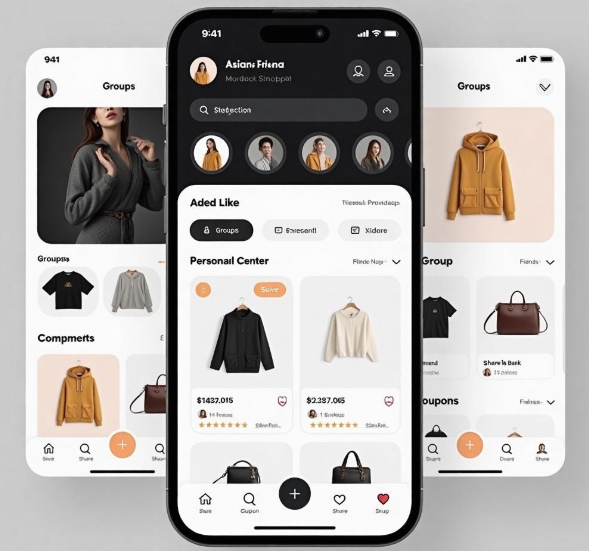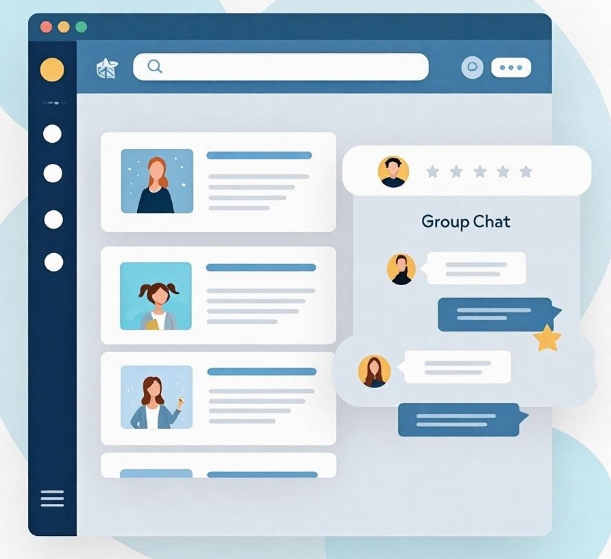Integration and Application of Mini Program Development with Social Media
- latest articles
- 1.DApp Development & Customization: Merging Diverse Market Needs with User Experience 2.Analysis of the Core Technical System in DApp Project Development 3.How to achieve cross-chain interoperability in Web3 projects? 4.How does the tokenization of points reconstruct the e-commerce ecosystem? 5.How to Set and Track Data Metrics for a Points Mall? 6.What is DApp Development? Core Concepts and Technical Analysis 7.Inventory of commonly used Web3 development tools and usage tips 8.Development of a Distribution System Integrated with Social E-commerce 9.Six Key Steps for Businesses to Build a Points Mall System 10.What is DApp Development? A Comprehensive Guide from Concept to Implementation
- Popular Articles
- 1.Future Trends and Technology Predictions for APP Development in 2025 2.Analysis of the DeFi Ecosystem: How Developers Can Participate in Decentralized Finance Innovation 3.From Zero to One: How PI Mall Revolutionizes the Traditional E-commerce Model 4.DAPP Development | Best Practices for Professional Customization and Rapid Launch 5.Recommended by the Web3 developer community: the most noteworthy forums and resources 6.How to Develop a Successful Douyin Mini Program: Technical Architecture and Best Practices 7.From Cloud Computing to Computing Power Leasing: Building a Flexible and Scalable Computing Resource Platform 8.Shared Bike System APP: The Convenient Choice in the Era of Smart Travel 9.How to Create a Successful Dating App: From Needs Analysis to User Experience Design 10.From Design to Development: The Complete Process of Bringing an APP Idea to Life
In the era of mobile internet, the integration and innovation of social media with various applications have consistently been a key driver of digital transformation. With the rise of platforms like WeChat and Alipay, more and more developers are focusing on mini-programs as an emerging application format. As a new type of lightweight application, mini-programs can achieve cross-platform functionality without the need for download and installation, giving them broad development prospects within social media platforms.
I. The Concept and Characteristics of Mini-Program Development
Mini-programs are lightweight applications developed on platforms like WeChat and Alipay, which can be used without downloading or installing. They possess the following key characteristics:
Lightweight and Fast
Compared to traditional mobile applications, mini-programs occupy less phone storage space and can be used without downloading, greatly enhancing the user experience. Their lightweight nature allows users to operate more conveniently and quickly.Cross-Platform Capability
Mini-program development is not targeted at a single platform but is uniformly developed for multiple platforms. Whether on WeChat, Alipay, or other platforms that support mini-programs, users can switch between different social platforms without needing to re-download or install.Rapid Iteration and Updates
Another significant advantage of mini-programs is their ability to undergo rapid updates and iterations. Developers do not need to go through traditional app store approval processes, allowing them to quickly release new features or fix issues, thereby ensuring continuous optimization of the user experience.Precise User Targeting
Since mini-programs mostly rely on social platforms, developers can use the data analysis tools provided by these platforms to accurately understand user behavior habits, interests, and preferences, thereby creating personalized push strategies and enhancing marketing effectiveness.
II. The Background of Mini-Programs and Social Media Integration
The rapid development of social media has provided fertile ground for the popularization of mini-programs. Taking WeChat as an example, its large user base and strong social media attributes have built a vast and active user ecosystem. Social platforms inherently possess strong social attributes, allowing users to interact through messages, friend circles, and other means. In this context, the emergence of mini-programs has filled the gap between social media and traditional applications.
Development and Popularization of Social Platforms
Social media, especially the widespread use of platforms like WeChat, QQ, and Douyin, has become an indispensable part of people's daily lives. Social platforms are no longer limited to communication and entertainment functions but increasingly focus on integrating various application features. As an important component of this, WeChat mini-programs provide users with more convenient services and experiences by seamlessly integrating into social scenarios.Diversification of Needs
As users' diverse needs for information acquisition, life services, online shopping, etc., continue to increase, traditional social platforms often cannot meet all these demands. Mini-programs fill this gap by offering various practical functions, enabling users to perform more operations within a single platform, thereby enhancing the stickiness and user activity of social platforms.Convenient Development and Promotion Methods
For businesses and merchants, mini-programs offer advantages such as low development barriers, flexible promotion methods, and high user conversion rates. Social platforms themselves have a broad user base and traffic resources. Combined with the rapid dissemination of mini-programs and the network effects of user social interactions, the effectiveness of marketing activities is greatly enhanced.
III. Application Cases of Mini-Programs Integrated with Social Media
In the process of integrating mini-programs with social media, many innovative application scenarios have emerged. The following are several typical application cases that demonstrate the great potential of their combination.
Social E-commerce
Social e-commerce is one of the most typical application scenarios of mini-programs integrated with social media in recent years. For example, through WeChat mini-programs, merchants can easily set up their own online stores and promote products using social scenarios like friend circles and group chats. Social e-commerce platforms can also drive user recommendations and conversions through social interactions, thereby achieving marketing goals.For instance, features like group buying, flash sales, and coupons in mini-programs, combined with the dissemination effects of social platforms, allow users to obtain more discounts through sharing and interaction, enhancing user participation and purchase desire.
Online Education and Social Interaction
In recent years, the integration of social platforms with the online education industry has also achieved significant results. Through WeChat mini-programs, users can learn and communicate anytime, anywhere, and teachers and students can interact through group chats and private messages. Mini-programs provide a convenient educational platform, helping users achieve socialized learning.In some educational institutions' social mini-programs, besides course content learning, social interaction features like online Q&A, discussion groups, and study check-ins are added, enhancing the fun and interactivity of learning and improving user learning outcomes and stickiness.
Socialized Content Platforms
In social platforms, content sharing and interaction are among the most common activities for users. Mini-programs can combine this social attribute with content platforms to create more personalized and interactive content sharing platforms. For example, users can publish their articles and short videos in friend circles through WeChat mini-programs and interact with friends through comments and likes.Such socialized content sharing platforms not only meet users' social needs but also push content more aligned with user interests through recommendation algorithms, thereby increasing user engagement and content dissemination effectiveness.
IV. Future Development Trends of Mini-Programs Integrated with Social Media
With continuous technological advancements and changing user needs, the integration of mini-programs and social media will usher in broader development space. The following are some future trends and possible development directions:
Deep Integration
The integration of mini-programs and social platforms will become increasingly deep, potentially leading to more seamless integration experiences in the future. For example, social platforms may not only host mini-programs but also intelligently recommend suitable ones based on user behavior data, further enhancing the user experience.Integration of Artificial Intelligence and Big Data
The development of artificial intelligence and big data technologies will bring more innovative opportunities to the integration of mini-programs and social media. By analyzing user behavior data, mini-programs can more accurately recommend personalized services and content to users, improving conversion rates and user experience.Cross-Platform Integration
With the rise of multiple social platforms, future mini-programs may achieve broader cross-platform integration. Users can seamlessly switch between different social platforms, and the functions and content of mini-programs can be shared across platforms, enhancing user convenience and stickiness.Richer Commercialization Models
The integration of mini-programs and social media not only changes the user experience but also brings more business opportunities to enterprises. In the future, with continuous innovation in models like social e-commerce and social advertising, mini-programs will become important marketing tools for businesses, driving further development of commercialization monetization.
Conclusion
As an emerging application form, the integration of mini-programs with social media provides vast space for digital transformation and business innovation. Leveraging the traffic and social attributes of social platforms, mini-programs achieve cross-platform dissemination and rapid promotion, becoming important tools connecting users and businesses. With continuous technological development, the integration of mini-programs and social media will show more diverse and innovative trends, making it worthy of our ongoing attention and exploration in the future.
-

How to Increase User Stickiness and Activity Through Mini Program Development
With the development of the internet and mobile internet, mini-programs, as an e···
-

How can mini-program development assist in corporate marketing and e-commerce transformation?
In today's rapidly evolving mobile internet landscape, corporate marketing and e···
-

Offline Functionality Design and Data Synchronization in Mini-Program Development
With the rapid development of mobile internet, mini-programs, as a lightweight a···

 Blockchain
Blockchain












